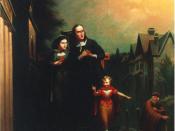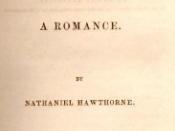Hester, What a Change!
The Puritans came from England in the sixteen hundreds to break free from the laws and regulations made by the king of England. In the new world, they were able to practice their own form of religion. The Puritans believed in God and His laws. 'A Young Puritan's Code' was 'Being sensible, that I am unable to do anything without God's help, I do humbly entreat him by his grace to enable me to keep these resolutions so far as they are agreeable to his will, for Christ sake.' (Jonathan Edwards) And they had over fourteen resolutions to keep. Although this is Jonathan Edwards interpretation, it was most likely the way the Puritan lived. And they probably obeyed it out of fear for their life. For sinners are in the hands of a angry God.
Many years later Nathaniel Hawthorn was greatly interested by the Puritans.
This 19th-century American novelist, was born on July 4, in Salem, Massachusetts, and died May 11, 1864. He was the first American writer to apply artistic judgment to Puritan society. He was intrigued by the psychological insight into the complexities of human motivations and actions. In The Scarlet Letter, he expressed one of the central legacies of American Puritanism, using the plight of Hester Prynne and Arthur Dimmesdale to illustrate the conflict between the desire to confess and the necessity of self-concealment. Hawthorne grew up with his two sisters and their widowed mother, and an uncle saw to his education at Bowdoin College. In 1852, Hawthorne wrote the campaign biography of Franklin Pierce, an old college friend. The best of Hawthorn's early fiction was gathered in Twice-Told Tales, Mosses from an Old Manse, and The Snow-Image. These capture the complexity's of the New England Puritan heritage. Hawthorne's writing had...


